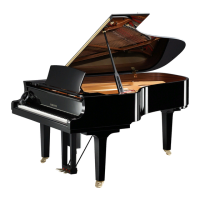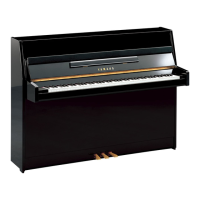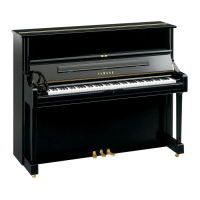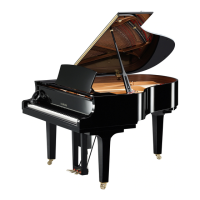Do you have a question about the Yamaha Disklavier MX100A and is the answer not in the manual?
Classifies Yamaha's hybrid pianos into distinct product groups.
Explains the core components and architecture of different hybrid piano models.
Details the specific characteristics and advancements of each Disklavier (DKV) series.
Introduces the high-end DKV PRO series, highlighting its advanced features.
Describes the various types of control units used in Disklavier pianos.
Explains the purpose and placement of switch boxes in different hybrid piano models.
Provides information on the types and purposes of various connection jacks on hybrid pianos.
Describes the different circuit sheets that comprise the internal components of hybrid models.
Covers the recording/playback capabilities and supported software file formats for hybrid pianos.
Details the storage capacities of floppy disks and internal flash memory used in hybrid models.
Shows where specific types of data are stored within different Disklavier models.
Explains PC connection methods and configurations for Disklavier pianos.
Describes the various sensors employed to detect piano performance actions.
Explains the piano tone generator and XG tone generator systems in hybrid pianos.
Lists the different power supply voltages used by the power-supply unit in hybrid models.
Shows version histories for the operating programs of major Disklavier models.
Outlines the overall steps for maintaining and servicing hybrid piano models.
Details the process for adjusting the shank stopper and let-off in UP silent piano models.
Explains the procedure for adjusting the shank stopper and regulating rods in GP silent models.
Discusses how action regulation varies between hybrid and conventional acoustic pianos.
Explains how to access and utilize the Maintenance mode for piano diagnostics and adjustments.
Details how to use Test Mode to check sheet functions and review instrument error history.
Describes sensor test procedures for models without controllers.
Explains how to verify sensor and tone-generator versions on models without controllers.
Details the function of DIP switches on the MN board for executing diagnostic checks.
Explains how to update programs via floppy disk or replace ROM chips.
Lists and describes error messages, providing corrective actions for each.
Classifies Yamaha's hybrid pianos into distinct product groups.
Explains the core components and architecture of different hybrid piano models.
Details the specific characteristics and advancements of each Disklavier (DKV) series.
Introduces the high-end DKV PRO series, highlighting its advanced features.
Describes the various types of control units used in Disklavier pianos.
Explains the purpose and placement of switch boxes in different hybrid piano models.
Provides information on the types and purposes of various connection jacks on hybrid pianos.
Describes the different circuit sheets that comprise the internal components of hybrid models.
Covers the recording/playback capabilities and supported software file formats for hybrid pianos.
Details the storage capacities of floppy disks and internal flash memory used in hybrid models.
Shows where specific types of data are stored within different Disklavier models.
Explains PC connection methods and configurations for Disklavier pianos.
Describes the various sensors employed to detect piano performance actions.
Explains the piano tone generator and XG tone generator systems in hybrid pianos.
Lists the different power supply voltages used by the power-supply unit in hybrid models.
Shows version histories for the operating programs of major Disklavier models.
Outlines the overall steps for maintaining and servicing hybrid piano models.
Details the process for adjusting the shank stopper and let-off in UP silent piano models.
Explains the procedure for adjusting the shank stopper and regulating rods in GP silent models.
Discusses how action regulation varies between hybrid and conventional acoustic pianos.
Explains how to access and utilize the Maintenance mode for piano diagnostics and adjustments.
Details how to use Test Mode to check sheet functions and review instrument error history.
Describes sensor test procedures for models without controllers.
Explains how to verify sensor and tone-generator versions on models without controllers.
Details the function of DIP switches on the MN board for executing diagnostic checks.
Explains how to update programs via floppy disk or replace ROM chips.
Lists and describes error messages, providing corrective actions for each.
| Model | MX100A |
|---|---|
| Keyboard | 88 keys |
| Disk Drive | 3.5-inch floppy disk drive |
| MIDI | Yes |
| Sound Source | AWM (Advanced Wave Memory) |
| Connectivity | Aux Out |











